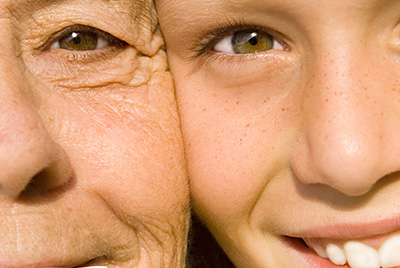Vision Loss and Age
Infancy and Childhood (Birth to Age 18)

American adults aged 40 years and older are at greatest risk for eye diseases.
In the United States, the most prevalent disabling childhood conditions are vision disorders including amblyopia, strabismus, and significant refractive errors. Early detection increases the likelihood of effective treatment; however, less than 15% of all preschool children receive an eye exam, and less than 22% of preschool children receive some type of vision screening. Vision screening for children scored on par with breast cancer screening for women.
Other eye diseases affecting this age group include retinopathy of prematurity (ROP), congenital defects, diabetic retinopathy (DR), and cancers such as retinoblastoma.
Adults Younger Than Age 40
Vision impairments in people younger than age 40 are mainly caused by refractive errors, which affect 25% of children and adolescents, and accidental eye injury. Approximately 1 million eye injuries occur each year, and 90% of these injuries are preventable. More than half (52%) of all patients treated for eye injuries are between ages 18 and 45 and almost 30% of those are 30–40 years (McGwin, Aiyuan, & Owsley, 2005). Additionally, diabetes affects this age group and is the leading cause of blindness among the working-age group 20–74.
Racial disparities occur in prevalence and incidence of some eye conditions. For example, among specific high-risk groups such as African Americans, early signs of glaucoma may begin in this age group, particularly if there is a family history for glaucoma. Lifestyle choices adopted during this period may adversely affect vision and eye health in later years (e.g., smoking, sunlight exposure).
Adults Older Than Age 40
American adults aged 40 years and older are at greatest risk for eye diseases; as a result, extensive population-based study data are available for this age group. The major eye diseases among people aged 40 years and older are cataract, diabetic retinopathy, glaucoma, and age-related macular degeneration. These diseases are often asymptomatic in the early treatable stages. The prevalence of blindness and vision impairment increases rapidly with age among all racial and ethnic groups, particularly after age 75 (Prevent Blindness America, 2002).
Although aging is unavoidable, evidence is mounting to show the association between some modifiable risk factors (i.e., smoking, ultraviolet light exposure, avoidable trauma, etc.) and these leading eye diseases affecting older Americans. Additional modifiable factors that might lend themselves to improved overall ocular health include a diet rich in antioxidants and maintenance of normal levels of blood sugar, lipids, total cholesterol, body weight, and blood pressure combined with regular exercise.
References
Bailey RN, Indian RW, Zhang X, Geiss LS, Duenas MR, Saaddine JB (2006). Visual impairment and eye care among older adults—five states. MMWR 2005:55:49; 1321–1325.
Centers for Disease Control and Prevention. Prevalence of disabilities and associated health conditions among adults—United States. MMWR 2001:50(7):120–5.
Prevent Blindness America, National Eye Institute. Vision Problems in the U. S.—Prevalence of Adult Vision Impairment and Age-Related Eye Disease in America. Schaumburg, IL: Prevent Blindness America, 2002.
McGwin G, Aiyuan X, Owsley C. Rate of eye injury in the United States. Arch of Ophthalmol 2005:123;970–976.
Yawn BP, Kurland M, Butterfield L, Johnson B. Barriers to seeking care following school vision screening in Rochester, Minnesota, J Sch Health 1998:68:8; 319–324.